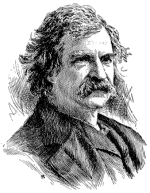The Boys’ Life of Mark Twain
by Paine

XV. The Wreck of the “Pennsylvania”
The “A. T. Lacy,” that brought Samuel Clemens up the river, was two days behind the “Pennsylvania.” At Greenville, Mississippi, a voice from the landing shouted “The “Pennsylvania” is blown up just below Memphis, at Ship Island. One hundred and fifty lives lost!”
It proved a true report. At six o’clock that warm mid-June morning, while loading wood, sixty miles below Memphis, four out of eight of the Pennsylvania’s boilers had suddenly exploded, with fearful results. Henry Clemens had been one of the victims. He had started to swim for the shore, only a few hundred yards away, but had turned back to assist in the rescue of others. What followed could not be clearly learned. He was terribly injured, and died on the fourth night after the catastrophe. His brother was with him by that time, and believed he recognized the exact fulfilment of his dream.
The young pilot’s grief was very great. In a letter home he spoke of the dying boy as “My darling, my pride, my glory, my all.” His heavy sorrow, and the fact that with unsparing self-blame he held himself in a measure responsible for his brother’s tragic death, saddened his early life. His early gaiety came back, but his face had taken on the serious, pathetic look which from that time it always wore in repose. Less than twenty- three, he had suddenly the look of thirty, and while Samuel Clemens in spirit, temperament, and features never would become really old, neither would he ever look really young again.
He returned to the river as steersman for George Ealer, whom he loved, and in September of that year obtained a full license as Mississippi River pilot from St. Louis to New Orleans. In eighteen months he had packed away in his head all those wearisome details and acquired that confidence that made him one of the elect. He knew every snag and bank and dead tree and depth in all those endless miles of shifting current, every cut-off and crossing. He could read the surface of the water by day, he could smell danger in the dark. To the writer of these chapters, Horace Bixby said:
“In a year and a half from the time he came to the river, Sam was not only a pilot, but a good one. Sam was a fine pilot, and in a day when piloting on the Mississippi required a great deal more brains and skill and application than it does now. There were no signal-lights along the shore in those days, and no search-lights on the vessels; everything was blind; and on a dark, misty night, in a river full of snags and shifting sandbars and changing shores, a pilot’s judgment had to be founded on absolute certainty.”
Bixby had returned from the Missouri by the time his pupil’s license was issued, and promptly took him as full partner on the “Crescent City,” and later on a fine new boat, the “New Falls City.” Still later, they appear to have been together on a very large boat, the “City of Memphis,” and again on the “Alonzo Child.”
 Continue...
Continue...![[Buy at Amazon]](http://images.amazon.com/images/P/B0006AHKG6.01.MZZZZZZZ.jpg)